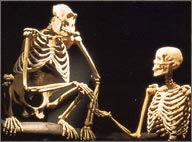WHAT IS BIOLOGICAL ANTHROPOLOGY?
Biological/Physical Anthropology Defined
The subject matter of this course overlaps the foci of several fields. As currently taught, it falls most clearly within the sphere of biological/physical anthropology.
Anthropology by definition [anthropos & logia] is the study of humans in all of their complexity. Biological anthropology takes as its focus the biological aspects of our existence. Critically, it does so within the framework of evolutionary theory and with attention to biocultural development, that is the interplay of biology and culture. The question that we, along with other anthropologists pose--what does it mean to be human?
(top) History of the Field Physical anthropology, the original name of the discipline, was initially spurred by interest in human variation during the period of exploration and the chance discovery of fossils. It began to develop as a separate discipline in Europe in the 1800s and through the campaigning of Ales Hrlicka, it was finally recognized as a separate field in 1928 with the founding of the American Association of Physical Anthropologists. Just as the hallmark of anthropology in the broad sense is its holistic perspective, physical anthropology is a synthesis of many fields. As physical anthropologists study physiology, anatomy, genetics, behavior, environment, adaptation, and evolution, they do so stressing the interrelationship among these spheres. In regard to the name, the development of genetics and increasing focus on biologically oriented topics in the last decades have led to a preference by some for the term "biological" anthropology as a replacement for the older "physical" anthropology. Both terms are currently in use, though the former is becoming more popular. Today, biological/physical anthropologists ask questions about a broad range of questions. Among them: How and why do humans vary biologically, both individually and by group? What are the patterns of biological variation, adaptation, life history and development? What is the source and evolutionary history of these differences at the molecular level? What is the interplay between ecology, genetics, and behavior, as well as structure and function among our closest relatives, the other primates? What can we learn from the fossil record about the evolutionary history of our closest relatives as well as ourselves? What can we learn about our recent history and the spread of populations, through the analysis of genetics, forensics and cultural remains? To give you a sense of the breadth of this research, the following is a sample from the leading journal in the field, The American Journal of Physical Anthropology: Reconstructing relationships among mortality, status, and gender at the Medieval Gilbertine Priory of St. Andrew, Fishergate, York. Biological/Physical Anthropology at Columbia
Biological anthropology has a long history at Columbia University. Franz Boas was named the first Professor of Anthropology at Columbia in 1899 and he came to be known as the father of American anthropology with his development of the "four-field approach." This perspective sought to integrate the various subfields of anthropology, specifically, cultural anthropology, linguistic anthropology, archeology and physical anthropology, into a single holistic study of humans. Boas himself conducted research in both the cultural and physical spheres. The American Anthropological Association [AAA], the primary professional society of anthropologists in the US, continues to maintain this approach through its mission statement to study humankind in all of its aspects, "through archeological, biological, ethnological, and linguistic research." Thus the "anthropology" in biological anthropology. Still, as each of the subfields has grown since the founding of the AAA in 1902, some researchers have found that this perspectives not optimal for their interests. The result has been the division of these fields in a variety of ways. For example, in some instances biological and cultural anthropology form separate departments with archeology either forming its own department as well or joining either the former or the latter. Alternatively, biological anthropology may move to biology related departments while cultural anthropology joins with sociology departments. As such, when one looks at the universities across this country for biological anthropology, one may find it in any number of departments but its primary focus and synthetic nature remain the same. With the creation of the Department of Ecology, Evolution and Environmental Biology at Columbia in the early years of the new century, biological anthropology shifted from the Department of Anthropology to this new department. This is a natural fit for the subject matter and will enable researchers in both departments to expand their foci while still allowing for interdisciplinary investigation, collaboration and integration. Our current faculty includes experts on genetics, primate behavioral ecology and paleoanthropology. We also have close ties to researchers at local institutions including the American Museum of Natural History and the Wildlife Trust thus enabling study of the range of biological/physical anthropology subject matter. (top) News
Anthropology News
- The latest news on a variety of anthropological subjects from newly discovered fossils to the most recent research
findings.
Discover Magazine - The site for the journal Discover is also worth a look. This monthly is geared toward the public and usually presents cent finds and analyses in science in a clear and engaging manner. You can also access this through Columbia libraries. Organizations
For those interested in learning more about the field of biological/physical anthropology the following sites may be of interest:American Association of Physical Anthropologists- This site includes information about graduate school and careers in the field. American Anthropological Association Forensic Anthropology - This site includes great images and information about sexing skeletons and the identification of pathologies. American Society of Primatologists (top) |

|
